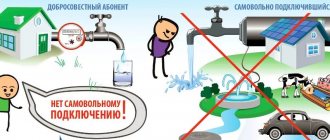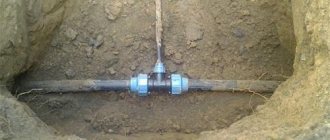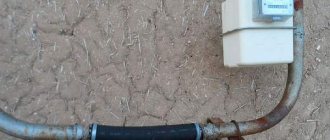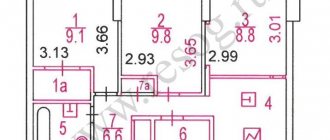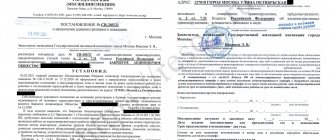In addition, such violators use water resources for free, since the volume of expenditures is not recorded. Please note that unauthorized connection to the water supply strictly punishable by law.
What is considered illegal tapping?
The procedure for water supply (sewage) is clearly regulated by law. These services should be provided by specialized organizations. And consumers need to independently or through the management company, HOA, enter into an appropriate agreement and pay for the consumed resource.
However, not all consumers fulfill their obligations under the law properly. Water supply companies often have to deal with cases of illegal connections to water supply networks. Such violations lead not only to free use of water, but also to disruptions in the system.
The definition of unauthorized tapping into the water supply system is given in the Rules for cold water supply and sanitation. They were approved by Government Decree No. 644 of July 29, 2013.
Unauthorized connection means connection to a centralized water supply (sewage) system in the absence of an agreement or in violation of its provisions. Using water for unauthorized tapping is illegal.
Potential Violators
Most often, illegal tapping into the heating or water supply system is carried out by the owners of a private house or premises attached to multi-apartment buildings.
Owners of small industrial premises, retail establishments, and service enterprises also violate the law. In order to connect correctly, you need to become a subscriber in accordance with the rules of the law.
IMPORTANT! If, when purchasing a home, the new owner discovers that an illegal tap has been made into the water supply or sewer system, he must notify the water utility or management company. Otherwise, he will bear responsibility for illegal actions.
The subscriber becomes an individual entrepreneur or legal entity that owns water supply systems connected to public water supply networks. Connection is carried out only on the basis of an agreement with the water supply company.
Subscribers also include organizations that manage housing stock, enterprises that transport water to the population, and manage engineering and technical infrastructure facilities.
Who should connect to water supply networks?
Connection to water supply systems must be carried out by specialists. Otherwise, errors may be made that affect the quality and safety of the provision of this utility service.
Persons wishing to connect to the water supply must submit an application to Vodokanal or another water supply organization in the city. Upon satisfaction of the application, an agreement is concluded with the subscriber and connection to the networks is carried out.
Upon receipt of an application for connection from land owners and self-government bodies, Vodokanal provides technical conditions for connection. If the applicant himself has determined the required load, then he applies for connection without first obtaining specifications.
Rules for connecting to a water supply or sewer system
The need to connect water supply and sewerage to a building arises in several cases - during the construction of a new building, during the reconstruction or restoration of an old one, or the repurposing of premises.
- The territorial water supply and sewerage service must obtain confirmation of the technical feasibility of connecting the building to utility systems.
- Local authorities, based on the conclusion of the water and waste management services, also issue confirmation of the possibility of carrying out work.
- You must also have a document on hand that specifies the technical conditions for the connection.
ATTENTION! To obtain technical conditions and permission from the organization that maintains the water supply system, an application for development is submitted.
It is also necessary to submit to this authority documents for ownership of the site where the work will be carried out, a designed balance for water consumption and drainage, and copies of the customer’s constituent documents.
Fines and other types of liability for illegal tapping into water pipes
If the connection to the water supply is illegal, the offender will be punished. The Code of Administrative Offenses provides for liability for violations when using and connecting to water supply systems.
Article 7.2 of the code establishes the following fines for violators:
- for individuals - one thousand to one thousand five hundred rubles;
- for officials - from two thousand to three thousand rubles;
- for organizations - from twenty thousand to thirty thousand rubles.
In addition to these fines, the consumer will have to pay for the water used during the entire previous period. The violator also risks falling under criminal liability under Art. 158 of the Criminal Code of the Russian Federation. This act is equivalent to theft committed from an oil or gas pipeline (clause “b”, part 3).
According to the criminal code, violations can even result in imprisonment of up to a year.
It is also important to take into account the fact that unauthorized connection can lead to damage to pipes and disruption of the system. Network owners can present their property claims against violators.
Fine for unauthorized sewer connection
If residents of an apartment building illegally connected to the sewer, they will also have to bear responsibility. Its size is also provided for in Art. 7.2. Code of Administrative Offences. Accordingly, the fine for citizens will be from 1000 to 1500 rubles.
Penalties
It should be borne in mind that the punishment for unauthorized connection to a sewer or water supply is quite strict and leads to big problems. Not only will water supply be limited , but also penalties will be imposed .
- Subscribers who illegally connected to water supply and sewerage systems receive a fine of up to one and a half thousand.
- The result of non-contractual consumption of cold water by a legal entity will be an act and penalties of up to 30 thousand rubles.
The financial losses that would result from the discovery of an unauthorized connection to the water supply will far exceed the costs that would be associated with a legal connection.
Lawyers advise not to violate the law on water consumption, because in addition to fines, you will have to endure the shutdown of the water supply and the costs of a legal connection.
Act on unauthorized connection to the water supply: requirements for the document and its sample
Illegal connections to networks are most often discovered during inspections. When a violation is detected, service organizations must draw up a written report . It reflects the following information:
- date and place of the inspection;
- persons carrying out the inspection;
- fact of violation;
- information about the offender;
- about the place of unauthorized tapping;
- belonging to networks that were illegally joined.
The act must be signed by the person who drew it up, as well as by the consumer. If he is absent or is unable to attend the inspection, his representative may come instead of the consumer. The powers of the representative must be confirmed by a power of attorney.
If no one appears, then the act may also be signed by the involved verification witnesses. In this case, the violator is sent a notification about the identified fact of illegal accession.
A sample act on the identification of illegal tapping can be downloaded from our website. ⇐
Sample warning
Based on the violation report drawn up by the utility service, a warning is issued to the consumer. It proposes to voluntarily stop unauthorized use of water and pay for the volume of resource consumed.
If the specified requirements are not met by the consumer, then the consumer faces prosecution, a lawsuit to collect the debt for the utility service, as well as being disconnected from the water supply by cutting off unauthorized pipes.
What does breaking the law entail?
will be detected sooner or later . The punishment procedure is a complex process, but it always ends negatively for the offender.
ATTENTION! It is prohibited to independently change the configuration of utility networks, make illegal connections even within a house or apartment, or change the indicators of water flow meters in the system.
- If the consumer decides to voluntarily connect to the water utility or does not comply with all technical conditions for water during connection, the water utility workers draw up a report. This is the first stage of the process. There is an act of detection of an unauthorized sample; all basic data will be indicated in it.
- The report must contain information about the address of the inspection, its date, and the fact of a violation. The document also indicates the enterprise that carries out unaccounted water use. Data about the water supplier and the subscriber are added.
Documents for legal insertion
In order for connection to the water supply not to be considered illegal, it is necessary to comply with the procedure established by law. If we are talking about supplying water to a private house, then the following documents are needed:
- application from the owner of the site;
- technical connection conditions;
- connection agreement.
The full list of required documentation should be clarified with Vodokanal or another water supply organization in the city. If documents are submitted by a representative, then it is necessary to present a power of attorney for him.
On-site inspection of water supply in a private house
Resource supply organizations arrange such inspections at different intervals, but most often the basis for them is complaints from the population. Worker visits are organized to check the operation of metering devices, verify readings, and search for illegal taps into the water supply system and other utility supply systems.
Such inspections can be scheduled, when employees go to the site at a long-determined moment. And there are unscheduled ones, when specialists are sent to a certain place for some reason: a complaint, a malfunction, inaccurate readings, etc.
How to find a sidebar
Visual inspection is usually used to find such connections. Each Vodokanal has connection diagrams by which you can check whether there is a certain connection on them or not.
Third-party organizations offer their services to search for illegal tappings using special equipment.
Is it possible not to allow employees of the management company, housing and communal services, water utility into the apartment or house to check meters or unauthorized connections?
Of course, you can not let him in, but there will be consequences for this. The procedure for checking meters and other equipment is described in the Government Decree “On the provision of public services...”. It clearly states that the organization has every right to conduct such inspections no more than once every six months.
However, the company has an obligation to warn residents about this 2 weeks before the event.
The owner has legal grounds not to allow representatives of the organization into his home, having warned at least 2 days before the inspection about his absence.
If the tenant did not warn anyone and did not let the representatives in, then they draw up an appropriate act of refusal to allow access to the meter. When 3 months have passed since its preparation, the organization has every right to carry out calculations not according to actual readings, but according to standards.
Model act on non-contractual consumption of water supply and sanitation
The act on non-contractual (unaccounted) water consumption is drawn up in any order. There are no samples; each company has the right to use its own form. Most often, in such cases, an act of unauthorized connection to the water supply is used, see below.
Act on unauthorized connection to water supply
A sample of this document can be downloaded from this link. ⇐
How to legalize tapping into a water supply
If the consumer has received a notification about the need to eliminate an unauthorized tap into the water supply or sewer system, he needs to take appropriate measures. Legalizing the completed connection will help you avoid a fine, especially criminal punishment.
The offender may try to legalize the connection made. To do this, you need to submit a corresponding application to the water supply organization. If the connection was carried out without technical violations, and the consumer paid for water, then there is a chance to legalize the connected pipes.
What to do if an unauthorized connection has already been made?
If you have already connected to the network without permission, you can try to avoid punishment.
One way is to contact utility officials. A positive, peaceful resolution of the problem is possible if the consumer did not know about the presence of the tie-in (for example, when buying a new house) and always paid utility bills on time, including payments for water and sewerage.
ATTENTION! In order to legitimize the connection, the owner of the site where it was carried out must write a statement.
If the user did not know about the presence of the tie-in, he will most likely avoid a fine. It will be enough to comply with all the orders of the water utility, obtain permission to legally connect to the water supply, and prove payment for water supply using receipts.
Unauthorized tapping into a water supply system: judicial practice
Issues regarding the elimination of violations by consumers who have illegally connected to water supply networks are often resolved by the court. In judicial practice, there are claims by owners of private water pipelines to declare connections to them illegal.
If there is evidence of this fact, the act of identifying an illegal connection by the court, the plaintiff’s demands are satisfied. An example is the decision of the Voroshilovsky District Court of Volgograd in case No. 2-348/2012.
The Dolinsky City Court of the Sakhalin Region in case No. 2-133/2015 satisfied the demands of Vodokanal-2 LLC against persons who made an unauthorized connection to the water supply. He collected the debt from the violators for unaccounted water consumption.
On January 25, 2021, the Industrial District Court of Stavropol denied the claim to the plaintiff in a similar case due to the expiration of the statute of limitations. As follows from practice, in order to satisfy claims in these disputes, the court must reliably establish the fact of illegal tapping by the defendant.
Sometimes people held accountable for unauthorized connection to the water supply also go to court. They usually challenge the legality of the act drawn up and the punishment imposed on them. The court may cancel the sanctions if it finds violations of the law.
Responsibilities of individuals
Judicial practice has examples of claims against individuals who made unauthorized connections into pipelines of engineering systems.
In addition to the fact that it is impossible to consume water without a contract, it is recommended to follow several more important rules .
- All regulations for the use of water supply and other communications must be observed.
- Compliance with safety precautions is mandatory.
- Among the consumer's responsibilities is access to representatives of the water utility or other service authority to the water supply system to check its operation, maintenance, and repair.
ATTENTION! Individuals should also know how to legalize a connection to the network in a private home, since an illegal pipeline will cause fines from the water utility, disconnection from the network, and other problems.
If water utility workers discover any violations, they can draw up a report , file a claim against the consumer, and impose a fine .
Disputes with the water utility in the presence of violations of the law will only entail additional costs.
How to legalize plumbing in a private house
What exactly is this procedure for legitimizing the tie-in? This is just an official certificate of connection to the water supply system.
In order to arrange everything legally, you will need to contact the company that owns the water supply system with the following list of papers:
- Statement.
- Passport.
- Documents confirming ownership of the house where the connection is being made.
You may also have to dismantle the old tie-in yourself if it does not meet technical and other requirements.
However, this is a dangerous activity that can lead to unforeseen consequences, so it is better to turn to professionals for such work.
Insertion depending on the type of pipes
Since main water pipelines are assembled from polymer, galvanized and cast iron pipes, we will consider all available options for arranging the tie-in.
No. 1 - working with polymer reinforcement
When dealing with polymer reinforcement, insertion technology is carried out in the following sequence. Having decided on the place where the pipe will be inserted, prepare the area. To do this, a flat area in the puncture area of the pipe body is thoroughly cleaned using sandpaper to remove any accumulations of rust and paint residues.
A clamp equipped with terminals for connecting a welding machine is fixed to the prepared place using bolts. After installing the unit and connecting the contacts of the welding machine to the terminals, voltage is applied to it.
When installing an electric-welded collapsible clamp on a polymer pipe, the structure is first disconnected into a vertical pipe with a valve, through the cavity of which the drilling nozzle is buried, and direct-flow pipes.
A clamp equipped with a flange is fixed to the pipeline, through which a valve equipped with a sleeve is attached.
At the other end of the lining, in the area where the drill will be buried, a valve with a sleeve is mounted. Drilling equipment is attached to it, after which a hole is carefully made in the line using a regular drill.
The drill must be inserted only through the shut-off valve in order to block the flow of water after “breaking through” the pipe body and freely remove the cutting tool. To ensure the tightness of the joint when drilling, use a special nozzle.
When inserting into a plastic pipeline by welding, making a hole and screwing in the valve is carried out only after the surface has completely cooled
The new section of the input pipe is connected to the flange located on the valve. The clamp is mounted above the insertion point, and then by heating the spiral of the welding machine is soldered to the pipe body. The result is a high-strength, sealed connection.
No. 2 - connecting cast iron pipes
If there is a cast iron pipe, which is much harder than its polymer analogues, the procedure is performed in the following sequence:
- At the site of the future “breakdown”, clean the area from rust and remove the layer of hot cast iron with a grinder.
- Install the saddle on the area, not forgetting to lay the rubber seals.
- A shut-off valve is attached to the flange outlet, into the cavity of which a crown is inserted.
- They begin to drill the pipe, not forgetting to cool the cut site and replace dull bits in a timely manner. You need to drill in several stages: first with a small-diameter drill, and then with a slightly larger one.
- After removing the crown from the valve, close the valve, cutting off the water supply from the pipe.
- Restore anti-corrosion coating and insulation.
To create holes in the cavity of cast iron pipes, crowns equipped with carbide cutting plates or drills with feather sharpening are used. When working with them, it is important to prevent overheating of the tool by periodically wetting the cutting parts with water.
To protect the power tool from water entering when the cutting part is removed from the hole, a protective screen is constructed from thick cardboard or rubber. It is placed between the body and the cartridge.
Tapping into a main pipe under pressure involves exposure to six working atmospheres, so it is important to ensure that there are no leaks at the joints
When using a saddle clamp to insert into a metal pipeline, rubber seals are used to ensure a tight fit to the surface.
A special machine can be additionally attached to such a device, the main elements of which are:
- locking bolt;
- handle with ratchet;
- flush tap;
- shaft with drill.
All structural elements are enclosed in a metal case. The presence of a guide coupling makes it possible to simplify the drilling process, in which the drill can be conveniently positioned in any direction.
No. 3 - features of working with steel pipes
Steel pipes are not inferior in ring rigidity to cast iron fittings. But steel is a more ductile iron-carbon alloy. Therefore, the insertion can be carried out by implementing a different technology, in which the joining method resembles that used when installing polymer pipes.
The technology of tapping into a steel pipeline includes a number of main stages:
- The area to be cut is excavated and cleaned of rust.
- A threaded or flanged pipe is mounted onto the pipe section by welding.
- The seams are welded.
- Check the seams for leaks.
- A flanged or threaded valve is fixed to the nozzle.
- The main pipe is drilled through the valve.
- A branch of the external water supply is installed behind the mounted valve.
Ideally, the pipe should be made of “main” fittings. But it is also possible to use any other type of rolled pipe, the basis for which is structural steel.
When drilling a main pipe, it is better to go through the first upper layers with a hammer drill, and the last millimeters, which require “jewelry” skill, by hand
This “trick” will help to clearly determine the tightness of the seams: they are coated with kerosene from the inside, and outlined with chalk contours from the outside. Defects in the tightness of the joint will be indicated by oil stains that appear on the outside of the structure.
The specifics of inserting into a plastic pipe when assembling a water supply system are described in detail in another popular article on our website.
What can be considered an illegal connection to water supply and sewerage?
Firstly, if the owner of the property does not have an officially confirmed and documented written contract with a local organization involved in the plumbing and sewerage system (water supply and sewerage).
Secondly, if all the conditions of the established regulations are not met. These regulations can be found in Decree of the Government of the Russian Federation No. 167 of February 12, 1999.
Examples of the most common violations of regulations:
- replacing or dismantling water meters for personal gain;
- re-equipment of load-bearing drains, inlets and other structures;
- absence of an agreement with the service organization.
Consequences of unauthorized connection
Paying a fine or facing criminal charges are not the only unpleasant consequences . Significant household damage is also noted, which is expressed in the following:
- water pressure drops throughout the entire building or apartment building;
- the quality of water is greatly deteriorating due to the lack of work to disinfect pipes and analyze the liquid entering them;
- unprofessional installation results in destruction or damage to water supply systems.
To connect legally, you need to collect the required documents. The package includes an application for drawing up technical specifications, the original and 7 copies of the situation plan, as well as the projected balance of water consumption and wastewater disposal. An order is attached from the authorized company to assume the position of the manager responsible for the tie-in. You will need to obtain a site plan from the town planning company .
The established rules for using utility networks oblige subscribers to allow specialists from service companies to access meters and, if necessary, equipment. The operation of water supply and sewerage must be carried out in compliance with safety regulations .
In some cases, it is possible to legitimize an already completed illegal connection. If the inspection shows that SNiP standards have not been violated, the tie-in may not be dismantled, but the water supply to this area may be suspended until all documents are collected and a fine is paid.
